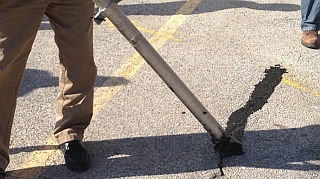October 21, 2015
 With winter around the corner, crack sealing/fill pavement will be the main focus for the INDOT maintenance department this fall.
With winter around the corner, crack sealing/fill pavement will be the main focus for the INDOT maintenance department this fall.
Cracking is one of the most common distresses encountered on asphalt or concrete. Cracking in an asphalt pavement is caused when traffic and temperature fluctuations create strains that the pavement cannot accommodate. Several factors influence crack development, including temperature extremes and rate of change, pavement structural design, aging characteristics of the asphalt cement, and traffic characteristics.
Crack sealing and filling of asphalt pavement is necessary to mitigate the infiltration of water and incompressibles into a pavement system. The effects of not sealing/filling cracks include increased deterioration, potholes and frost heave damage. Typically crack sealing/filling operations are conducted during the moderate spring and fall temperatures when the cracks are midway between the extremes. These operations are conducted in dry conditions and while the temperature is between 45 and 65 degrees. If a treatment is placed too early in the spring or too late in the fall, moisture may be present in the pavement creating frost action that will render a seal or fill ineffective.
Crack filling is used to reduce the amount of water infiltrating into pavement and reinforce the adjacent pavement. Crack filling is applied to cracks unsuitable for sealing and to non-working cracks. Non-working cracks are defined as those that experience relatively little horizontal and/or vertical movement as a result of temperature change and/or traffic volume. Cracks are air blasted to remove dust and debris as well as any loose particles. Once air blasting is complete the sealing/filling operation begins. The material is applied in a continuous motion from the bottom of the crack up to reduce the chance of trapping air beneath the material. Blotting protects the uncured crack treatment material from tracking under traffic. Blotting material is usually used in areas where traffic has to travel on the material before it has time to cure. The blotting material should be applied immediately after the material is placed and finished. Toilet paper or sand are commonly used as blotting materials.